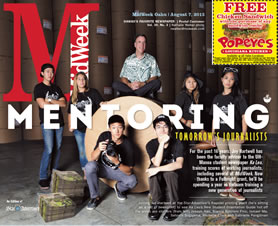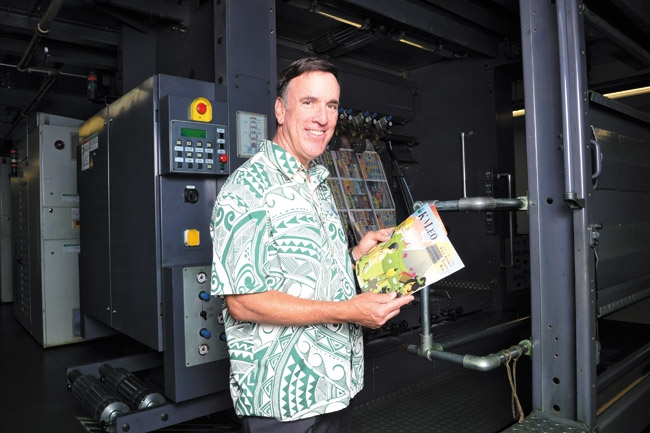Mentoring Tomorrow’s Journalists
For the past 16 years, Jay Hartwell has been the faculty adviser to the UHManoa student newspaper Ka Leo, training scores of working journalists, including several at MidWeek. Now, thanks to a Fulbright grant, he’ll be spending a year in Vietnam training a new generation of journalists
Jay Hartwell’s career as an educator is marked by his selfless devotion for those he has mentored.
For 16 years he has served as the student media adviser for Ka Leo O Hawaii, the University of Hawaii at Manoa’s student newspaper. Equipped with a wealth of wisdom and aptitude of his own, he has dedicated the latter half of his career to sharing his knowledge and resources within the media industry with the students who walk through Ka Leo‘s bustling newsroom.
On Aug. 17, he will travel to Hue, Vietnam, with a grant through the Fulbright U.S. Scholar Program to lay the foundation that he hopes will begin to provide aspiring college journalists there the same opportunities.
“I’m not going to Vietnam on a crusade, that’s not my job,” he says. “My job is to create good experiences for the students in the universities I’m working with, and hopefully in the process, through the relationships that we develop, the faculty and administrators at those schools will see the value.”
EARLY BEGINNINGS
Becoming an adviser to students wasn’t always part of his plan.
He was born in the heart of New York to two parents whose professions would eventually become his own.
His mother, Patricia, was a World War II news correspondent who later worked at the United Nations with UNICEF. His father, Dickson, was a magazine writer. Together, they ran a publication they owned in Arizona before retiring and moving the family to Kailua.
One of four sons, he was the only child to express an interest in becoming a journalist.
“You know how some kids whose parents were musicians grew up playing the piano all the time – I grew up always typing,” he says. “In fact, my parents sent me to typing school in elementary school.”
Throughout his early life, he continuously sought experiences that would allow him to enhance and hone his burgeoning journalistic skills. He was the editor of The Surfrider during his senior year at Kailua High, and also tried his hand at broadcast media.
After completing graduate studies at Columbia University, he eventually went to work for The Honolulu Advertiser as a general assignment reporter.
“I was very fortunate at The Advertiser to be able to cover issues that were not previously being covered involving the Hawaiian community, and I was learning so much,” he says.
Soon he found himself with a new opportunity, writing a book, Na Mamo: Hawaiian People Today.
“I had, in my eight years, gone about as far as I thought I could go as a reporter and wanted another challenge that the book provided,” he says.
Published in 1996, the book was a recipient of two awards from the Hawaii Book Publishers Association: Book of the Year and Excellence in Hawaiian Culture.
JAY, THE TEACHER
With the book complete and in need of a new challenge, he applied with the university to be its adviser for the student newspaper.
His focus has, and continues to be, the growth and development of his students.
“I think the main thing is, you never stop teaching,” he says.
As Ka Leo‘s adviser, he provides critiques to the editorial staff for each issue published. He also is readily available to writers looking for further advice on improving their craft.
“He would sit down with me and tell me what the strengths were, what the weak points of the story were, and he helped me,” says Yu Shing Ting, MidWeek‘s managing editor, who served first as a staff writer and then as associate news editor and news editor while at Ka Leo.
“He’s very welcoming, so it’s just really easy to talk to him,” says current Ka Leo editor Bianca Bystrom Pino, “and I think some people don’t have that luck with an adviser.”
“Any time we have an opening on our staff, the first thing I do is call Jay to see if he has any potential candidates,” says MidWeek editor Don Chapman. “I don’t think most people realize what good journalists come out of Ka Leo.”
Hartwell conducts workshops for the staff with local journalists to provide students with opportunities to learn and meet with professionals in the industry.
It’s a resource he extends to younger journalists as well.
A board member of the Hawaii Publishers Association since 2010, he makes it a point to include high school students in the learning process, coordinating HPA’s annual High School Journalism Awards.
He also organizes the High School Journalism Day annually for students who participate in their school newspapers. Last year, in lieu of a keynote speech and prior to the mayoral elections, he organized a debate between current mayor Kirk Caldwell and opponent former Gov. Ben Cayetano.
Students who take part in the day’s events also are given the opportunity to hone their writing skills with the guidance of professionals.
“The University of Hawaii has made a commitment to co-curricular programs such as student media programs,” he says. “That same commitment, primarily I think for staffing and financial reasons, does not exist in high schools. And yet all the studies show that high school students who are involved in media programs do better in courses, do better on the SATs, are more engaged in learning and do better in college than students who don’t participate in these programs.”
Those who took the time to get to know him while at Ka Leo also know that he makes it a point to care about life after college. Chances are, if you are a Ka Leo alum, he may have taught you how to write your first resume.
“Jay was one of the few teachers I had who I stayed in touch with because he was able to help me, even after I left Ka Leo,” says first-term state Rep. Beth Fukumoto. “When I came back from my master’s program, he was able to give me suggestions on where to apply for jobs, and he put feelers out to help me figure out where I should go and what I should do.
“I thought that was really helpful because he was invested in the students, more so than a lot of other professors were.”
For Hartwell, it’s simply something he believes comes with the job.
“A lot of what I do is just opening doors for people who didn’t recognize that the door even existed,” he says. “And when they see that it’s open, and they can step through and have an experience they didn’t dream was possible, that’s the best part.”
His excellence in teaching most recently was recognized in 2012 with the College Media Association’s Reid H. Montgomery Distinguished Service Award.
TO VIETNAM
A year and a half ago, a family friend invited Hartwell to visit Vietnam. While there, he taught journalism to elementary school students. Curious to know what the curriculum for university journalism students was, he visited one nearby.
He returned to Hawaii but traveled back to Vietnam for two weeks in the winter to create a feature magazine with university students there, essentially recreating the Ka Leo experience.
“I realized then that this would be a great opportunity to share what is common at many American universities and high schools,” he says. “A co-curricular learning experience that, if successful, might eventually be adopted within the university system there … that’s my hope that the Fulbright will provide.”
He joins approximately 1,100 other U.S. faculty and professionals traveling abroad through the Fulbright U.S. Scholar Program in the 2013-2014 year.
“Depending on which program you apply for, the Fulbright program provides you, essentially pays you to be an ambassador and to share your expertise in the hosted university where you’re sent,” he says.
He will be based at Hue University of Sciences, though he plans to travel to other universities and meet with professional organizations throughout the country to hold workshops. The courses will be two-week non-credit workshops.
“They do it in addition to their coursework, and it’s up to the students whether they want to produce an online journal, a printed journal, a news magazine or a photo magazine – each two-week block that I’m doing this will depend on the group that I’m with and depend on the focus they may want to do,” he says.
His wife of 25 years, Cindy, and their two children will join him in Vietnam and periodically explore other areas of Asia. The position will require him to be there for approximately one year, after which he plans to return to UH.
“I love this program (Ka Leo),” he says. “I feel like I’ve got the best job at the University of Hawaii – working with students who want to be here, who have so much desire to do their best and to learn at the same time.
“I feel incredibly fortunate, and I’m grateful that the university is going to grant me a leave to do this because it wouldn’t be possible without their support.”
Though he won’t have the 16 years he has had to strengthen Ka Leo, he is hopeful that the doors he opens for aspiring journalists in Vietnam will continue to provide them with opportunities for growth.
“Just as it takes a long time to achieve things within American bureaucracies, I’m sure the same is true there,” he says. “This is just the beginning.”







